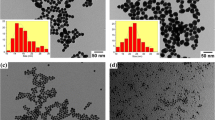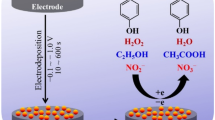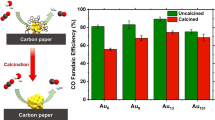Abstract
The measurement procedure of oxophilicity and electrocatalytic activity for oxygen reduction reaction (ORR) on size-selected Au clusters was developed and applied. Mass-selected Au9 clusters were deposited on a glassy carbon substrate under ultrahigh vacuum (UHV) conditions, and the model electrode was transferred to an electrochemical cell with the rotating disk electrode (RDE) configuration. Cyclic voltammetry exhibited a significantly lower oxide-reduction peak potential of the Au clusters than that of bulk Au in the first cycle, thus confirming the exceptionally higher oxophilicities for the former. After performing cyclic voltammetry with an upper limit potential of 1.8 V versus a reversible hydrogen electrode, the ORR activity of the Au clusters was lower than that of bulk Au and bulk Pt. This result was partially ascribed to aggregations of Au clusters during the potential cycles.

ᅟ







Similar content being viewed by others
References
H.A. Gasteiger, J.E. Panels, S.G. Yan, Dependence of PEM fuel cell performance on catalyst loading. J. Power Sources 127(1–2), 162–171 (2004). https://doi.org/10.1016/j.jpowsour.2003.09.013
J.K. Norskov, J. Rossmeisl, A. Logadottir, L. Lindqvist, J.R. Kitchin, T. Bligaard, H. Jonsson, Origin of the overpotential for oxygen reduction at a fuel-cell cathode. J. Phys. Chem. B 108(46), 17886–17892 (2004). https://doi.org/10.1021/jp047349j
T.H. Yu, T. Hofmann, Y. Sha, B.V. Merinov, D.J. Myers, C. Heske, W.A. Goddard, Finding correlations of the oxygen reduction reaction activity of transition metal catalysts with parameters obtained from quantum mechanics. J. Phys. Chem. C 117(50), 26598–26607 (2013). https://doi.org/10.1021/jp4071554
T. Toda, H. Igarashi, M. Watanabe, Role of electronic property of Pt and Pt alloys on electrocatalytic reduction of oxygen. J. Electrochem. Soc. 145(12), 4185–4188 (1998). https://doi.org/10.1149/1.1838934
V.R. Stamenkovic, B. Fowler, B.S. Mun, G.F. Wang, P.N. Ross, C.A. Lucas, N.M. Markovic, Improved oxygen reduction activity on Pt3Ni (111) via increased surface site availability. Science 315(5811), 493–497 (2007). https://doi.org/10.1126/science.1135941
C.H. Cui, L. Gan, H.H. Li, S.H. Yu, M. Heggen, P. Strasser, Octahedral PtNi nanoparticle catalysts: exceptional oxygen reduction activity by tuning the alloy particle surface composition. Nano Lett. 12(11), 5885–5889 (2012). https://doi.org/10.1021/nl3032795
X.Q. Huang, Z.P. Zhao, L. Cao, Y. Chen, E.B. Zhu, Z.Y. Lin, M.F. Li, A.M. Yan, A. Zettl, Y.M. Wang, X.F. Duan, T. Mueller, Y. Huang, High-performance transition metal-doped Pt3Ni octahedra for oxygen reduction reaction. Science 348(6240), 1230–1234 (2015). https://doi.org/10.1126/science.aaa8765
J. Zhang, F.H.B. Lima, M.H. Shao, K. Sasaki, J.X. Wang, J. Hanson, R.R. Adzic, Platinum monolayer on nonnoble metal–noble metal core–shell nanoparticle electrocatalysts for O2 reduction. J. Phys. Chem. B 109(48), 22701–22704 (2005). https://doi.org/10.1021/jp055634c
M.F. Li, Z.P. Zhao, T. Cheng, A. Fortunelli, C.Y. Chen, R. Yu, Q.H. Zhang, L. Gu, B.V. Merinov, Z.Y. Lin, E.B. Zhu, T. Yu, Q.Y. Jia, J.H. Guo, L. Zhang, W.A. Goddard, Y. Huang, X.F. Duan, Ultrafine jagged platinum nanowires enable ultrahigh mass activity for the oxygen reduction reaction. Science 354(6318), 1414–1419 (2016). https://doi.org/10.1126/science.aaf9050
J. Snyder, T. Fujita, M.W. Chen, J. Erlebacher, Oxygen reduction in nanoporous metal-ionic liquid composite electrocatalysts. Nat. Mater. 9(11), 904–907 (2010). https://doi.org/10.1038/nmat2878
G.R. Zhang, M. Munoz, B.J.M. Etzold, Accelerating oxygen-reduction catalysts through preventing poisoning with non-reactive species by using hydrophobic ionic liquids. Angew. Chem.-Int. Edit. 55(6), 2257–2261 (2016). https://doi.org/10.1002/anie.201508338
K. Huang, T. Song, O. Morales-Collazo, H. Jia, J.F. Brennecke, Enhancing Pt/C catalysts for the oxygen reduction reaction with protic ionic liquids: the effect of anion structure. J. Electrochem. Soc. 164(13), F1448–F1459 (2017). https://doi.org/10.1149/2.1071713jes
N. Nonoyama, S. Okazaki, A.Z. Weber, Y. Ikogi, T. Yoshida, Analysis of oxygen-transport diffusion resistance in proton-exchange-membrane fuel cells. J. Electrochem. Soc. 158(4), B416–B423 (2011). https://doi.org/10.1149/1.3546038
R. Jinnouchi, K. Kudo, N. Kitano, Y. Morimoto, Molecular dynamics simulations on O2 permeation through nafion ionomer on platinum surface. Electrochim. Acta 188, 767–776 (2016). https://doi.org/10.1016/j.electacta.2015.12.031
A. Kongkanand, M.F. Mathias, The priority and challenge of high-power performance of low-platinum proton-exchange membrane fuel cells. J. Phys. Chem. Lett. 7(7), 1127–1137 (2016). https://doi.org/10.1021/acs.jpclett.6b00216
J.L. Zhang, M.B. Vukmirovic, Y. Xu, M. Mavrikakis, R.R. Adzic, Controlling the catalytic activity of platinum-monolayer electrocatalysts for oxygen reduction with different substrates. Angew. Chem.-Int. Edit. 44(14), 2132–2135 (2005). https://doi.org/10.1002/anie.200462335
K. Shinozaki, Y. Morimoto, B.S. Pivovar, S.S. Kocha, Re-examination of the Pt particle size effect on the oxygen reduction reaction for ultrathin uniform Pt/C catalyst layers without influence from Nafion. Electrochim. Acta 213, 783–790 (2016). https://doi.org/10.1016/j.electacta.2016.08.001
H.A. Gasteiger, S.S. Kocha, B. Sompalli, F.T. Wagner, Activity benchmarks and requirements for Pt, Pt-alloy, and non-Pt oxygen reduction catalysts for PEMFCs. Applied Catalysis B-Environmental 56(1–2), 9–35 (2005). https://doi.org/10.1016/j.apcatb.2004.06.021
F.J. Perez-Alonso, D.N. McCarthy, A. Nierhoff, P. Hernandez-Fernandez, C. Strebel, I.E.L. Stephens, J.H. Nielsen, I. Chorkendorff, The effect of size on the oxygen electroreduction activity of mass-selected platinum nanoparticles. Angew. Chem.-Int. Edit. 51(19), 4641–4643 (2012). https://doi.org/10.1002/anie.201200586
G.A. Tritsaris, J. Greeley, J. Rossmeisl, J.K. Norskov, Atomic-scale modeling of particle size effects for the oxygen reduction reaction on Pt. Catal. Lett. 141(7), 909–913 (2011). https://doi.org/10.1007/s10562-011-0637-8
M.H. Shao, A. Peles, K. Shoemaker, Electrocatalysis on platinum nanoparticles: particle size effect on oxygen reduction reaction activity. Nano Lett. 11(9), 3714–3719 (2011). https://doi.org/10.1021/nl2017459
M. Nesselberger, M. Roefzaad, R.F. Hamou, P.U. Biedermann, F.F. Schweinberger, S. Kunz, K. Schloegl, G.K.H. Wiberg, S. Ashton, U. Heiz, K.J.J. Mayrhofer, M. Arenz, The effect of particle proximity on the oxygen reduction rate of size-selected platinum clusters. Nat. Mater. 12(10), 919–924 (2013). https://doi.org/10.1038/nmat3712
E.F. Holby, W.C. Sheng, Y. Shao-Horn, D. Morgan, Pt nanoparticle stability in PEM fuel cells: influence of particle size distribution and crossover hydrogen. Energy Environ. Sci. 2(8), 865–871 (2009). https://doi.org/10.1039/b821622n
K. Matsutani, K. Hayakawa, T. Tada, Effect of particle size of platinum and platinum-cobalt catalysts on stability against load cycling. Platin. Met. Rev. 54(4), 223–232 (2010). https://doi.org/10.1595/147106710x523698
S. Garbarino, A. Pereira, C. Hamel, E. Irissou, M. Chaker, D. Guay, Effect of size on the electrochemical stability of Pt nanoparticles deposited on gold substrate. J. Phys. Chem. C 114(7), 2980–2988 (2010). https://doi.org/10.1021/jp908724k
Z. Yang, S. Ball, D. Condit, M. Gummalla, Systematic study on the impact of Pt particle size and operating conditions on PEMFC cathode catalyst durability. J. Electrochem. Soc. 158(11), B1439–B1445 (2011). https://doi.org/10.1149/2.081111jes
Z. Xu, H.M. Zhang, H.X. Zhong, Q.H. Lu, Y.F. Wang, D.S. Su, Effect of particle size on the activity and durability of the Pt/C electrocatalyst for proton exchange membrane fuel cells. Applied Catalysis B-Environmental 111, 264–270 (2012). https://doi.org/10.1016/j.apcatb.2011.10.007
K. Yu, D.J. Groom, X.P. Wang, Z.W. Yang, M. Gummalla, S.C. Ball, D.J. Myers, P.J. Ferreira, Degradation mechanisms of platinum nanoparticle catalysts in proton exchange membrane fuel cells: the role of particle size. Chem. Mater. 26(19), 5540–5548 (2014). https://doi.org/10.1021/cm501867c
C. Tsai, F. Abild-Pedersen, J.K. Norskov, Tuning the MoS2 edge-site activity for hydrogen evolution via support interactions. Nano Lett. 14(3), 1381–1387 (2014). https://doi.org/10.1021/nl404444k
S.L. Zhao, Y. Wang, J.C. Dong, C.T. He, H.J. Yin, P.F. An, K. Zhao, X.F. Zhang, C. Gao, L.J. Zhang, J.W. Lv, J.X. Wang, J.Q. Zhang, A.M. Khattak, N.A. Khan, Z.X. Wei, J. Zhang, S.Q. Liu, H.J. Zhao, Z.Y. Tang, Ultrathin metal-organic framework nanosheets for electrocatalytic oxygen evolution. Nature Energy 1, 1–10 (2016). https://doi.org/10.1038/nenergy.2016.184
Yin, H.J., Zhao, S.L., Zhao, K., Muqsit, A., Tang, H.J., Chang, L., Zhao, H.J., Gao, Y., Tang, Z.Y.: Ultrathin platinum nanowires grown on single-layered nickel hydroxide with high hydrogen evolution activity. Nat. Commun.6 (2015). https://doi.org/10.1038/ncomms7430
S.L. Zhao, H.J. Yin, L. Du, L.C. He, K. Zhao, L. Chang, G.P. Yin, H.J. Zhao, S.Q. Liu, Z.Y. Tang, Carbonized nanoscale metal-organic frameworks as high performance electrocatalyst for oxygen reduction reaction. ACS Nano 8(12), 12660–12668 (2014). https://doi.org/10.1021/nn505582e
X.X. Wang, J.D. Yang, H.J. Yin, R. Song, Z.Y. Tang, “Raisin Bun”-like nanocomposites of palladium clusters and porphyrin for superior formic acid oxidation. Adv. Mater. 25(19), 2728–2732 (2013). https://doi.org/10.1002/adma.201205168
M. Haruta, Size- and support-dependency in the catalysis of gold. Catal. Today 36(1), 153–166 (1997). https://doi.org/10.1016/s0920-5861(96)00208-8
S. Yamazoe, K. Koyasu, T. Tsukuda, Nonscalable oxidation catalysis of gold clusters. Acc. Chem. Res. 47(3), 816–824 (2014). https://doi.org/10.1021/ar400209a
J. Greeley, J. Rossmeisl, A. Hellman, J.K. Norskov, Theoretical trends in particle size effects for the oxygen reduction reaction. Z. Physik. Chem.-Int. J. Res. Phys. Chem. Chem. Phys. 221(9–10), 1209–1220 (2007). https://doi.org/10.1524/zpch.2007.221.9-10.1209
W. Chen, S. Chen, Oxygen electroreduction catalyzed by gold nanoclusters: strong core size effects. Angew. Chem. Int. Ed. 48(24), 4386–4389 (2009). https://doi.org/10.1002/anie.200901185
C. Jeyabharathi, S.S. Kumar, G.V.M. Kiruthika, K.L.N. Phani, Aqueous CTAB-assisted electrodeposition of gold atomic clusters and their oxygen reduction electrocatalytic activity in acid solutions. Angew. Chem.-Int. Edit. 49(16), 2925–2928 (2010). https://doi.org/10.1002/anie.200905614
L.K. Wang, Z.H. Tang, W. Yan, H.Y. Yang, Q.N. Wang, S.W. Chen, Porous carbon-supported gold nanoparticles for oxygen reduction reaction: effects of nanoparticle size. ACS Appl. Mater. Interfaces 8(32), 20635–20641 (2016). https://doi.org/10.1021/acsami.6b02223
S.J. Xu, P.Y. Wu, Facile and green synthesis of a surfactant-free Au clusters/reduced graphene oxide composite as an efficient electrocatalyst for the oxygen reduction reaction. J. Mater. Chem. A 2(33), 13682–13690 (2014). https://doi.org/10.1039/c4ta01417k
T. Inasaki, S. Kobayashi, Particle size effects of gold on the kinetics of the oxygen reduction at chemically prepared Au/C catalysts. Electrochim. Acta 54(21), 4893–4897 (2009). https://doi.org/10.1016/j.electacta.2009.02.075
J.H. Shim, J. Kim, C. Lee, Y. Lee, Electrocatalytic activity of gold and gold nanoparticles improved by electrochemical pretreatment. J. Phys. Chem. C 115(1), 305–309 (2011). https://doi.org/10.1021/jp1067507
M.J. Rodriguez-Vazquez, M.C. Blanco, R. Lourido, C. Vazquez-Vazquez, E. Pastor, G.A. Planes, J. Rivas, M.A. Lopez-Quintela, Synthesis of atomic gold clusters with strong electrocatalytic activities. Langmuir 24(21), 12690–12694 (2008). https://doi.org/10.1021/la8018474
I. Yagi, T. Ishida, K. Uosaki, Electrocatalytic reduction of oxygen to water at Au nanoclusters vacuum-evaporated on boron-doped diamond in acidic solution. Electrochem. Commun. 6(8), 773–779 (2004). https://doi.org/10.1016/j.elecom.2004.05.025
H.J. Yin, H.J. Tang, D. Wang, Y. Gao, Z.Y. Tang, Facile synthesis of surfactant-free Au cluster/graphene hybrids for high-performance oxygen reduction reaction. ACS Nano 6(9), 8288–8297 (2012). https://doi.org/10.1021/nn302984x
R.J.C. Batista, M.S.C. Mazzoni, H. Chacham, First-principles investigation of electrochemical properties of gold nanoparticles. Nanotechnology 21(6), 8 (2010). https://doi.org/10.1088/0957-4484/21/6/065705
Y. Watanabe, N. Isomura, A new experimental setup for high-pressure catalytic activity measurements on surface deposited mass-selected Pt clusters. J. Vac. Sci. Technol. A 27(5), 1153–1158 (2009). https://doi.org/10.1116/1.3179160
Y. Watanabe, X.Y. Wu, H. Hirata, N. Isomura, Size-dependent catalytic activity and geometries of size-selected Pt clusters on TiO2(110) surfaces. Catal. Sci. Technol. 1(8), 1490–1495 (2011). https://doi.org/10.1039/c1cy00204j
S. Proch, M. Wirth, H.S. White, S.L. Anderson, Strong effects of cluster size and air exposure on oxygen reduction and carbon oxidation electrocatalysis by size-selected Pt n (n ≤ 11) on glassy carbon electrodes. J. Am. Chem. Soc. 135(8), 3073–3086 (2013). https://doi.org/10.1021/ja309868z
M.D. Kane, F.S. Roberts, S.L. Anderson, Mass-selected supported cluster catalysts: size effects on CO oxidation activity, electronic structure, and thermal stability of Pd n /alumina (n ≤ 30) model catalysts. Int. J. Mass Spectrom. 370, 1–15 (2014). https://doi.org/10.1016/j.ijms.2014.06.018
A. von Weber, S.L. Anderson, Electrocatalysis by mass-selected Pt-n clusters. Acc. Chem. Res. 49(11), 2632–2639 (2016). https://doi.org/10.1021/acs.accounts.6b00387
F.F. Schweinberger, M.J. Berr, M. Doblinger, C. Wolff, K.E. Sanwald, A.S. Crampton, C.J. Ridge, F. Jackel, J. Feldmann, M. Tschurl, U. Heiz, Cluster size effects in the photocatalytic hydrogen evolution reaction. J. Am. Chem. Soc. 135(36), 13262–13265 (2013). https://doi.org/10.1021/ja406070q
L. Shi, L.Y. Zhu, J. Guo, L.J. Zhang, Y.N. Shi, Y. Zhang, K. Hou, Y.L. Zheng, Y.F. Zhu, J.W. Lv, S.Q. Liu, Z.Y. Tang, Self-assembly of chiral gold clusters into crystalline nanocubes of exceptional optical activity. Angew. Chem.-Int. Edit. 56(48), 15397–15401 (2017). https://doi.org/10.1002/anie.201709827
A.J. Bard, L.R. Faulkner, Electrochemical Methods: Fundamentals and Applications (Wiley, Hoboken, 2001), pp. 339–341
A. Bjorling, E. Ahlberg, J.M. Feliu, Kinetics of surface modification induced by submonolayer electrochemical oxygen adsorption on Pt(1 1 1). Electrochem. Commun. 12(3), 359–361 (2010). https://doi.org/10.1016/j.elecom.2009.12.034
B.D. Cahan, H.M. Villullas, The hanging meniscus rotating-disk (HMRD). J. Electroanal. Chem. 307(1–2), 263–268 (1991). https://doi.org/10.1016/0022-0728(91)85553-2
J.C. Fuggle, E. Kallne, L.M. Watson, D.J. Fabian, Electronic-structure of aluminum and aluminum-noble-metal alloys studied by soft-X-ray and X-ray photoelectron spectroscopies. Phys. Rev. B 16(2), 750–761 (1977). https://doi.org/10.1103/PhysRevB.16.750
S. Peters, S. Peredkov, M. Neeb, W. Eberhardt, M. Al-Hada, Size-dependent XPS spectra of small supported Au-clusters. Surf. Sci. 608, 129–134 (2013). https://doi.org/10.1016/j.susc.2012.09.024
W.E. Kaden, T.P. Wu, W.A. Kunkel, S.L. Anderson, Electronic structure controls reactivity of size-selected Pd clusters adsorbed on TiO2 surfaces. Science 326(5954), 826–829 (2009). https://doi.org/10.1126/science.1180297
G.K. Wertheim, S.B. Dicenzo, Cluster growth and core-electron binding-energies in supported metal-clusters. Phys. Rev. B 37(2), 844–847 (1988). https://doi.org/10.1103/PhysRevB.37.844
A. Sarapuu, M. Nurmik, H. Mandar, A. Rosental, T. Laaksonen, K. Kontturi, D.J. Schiffrin, K. Tammeveski, Electrochemical reduction of oxygen on nanostructured gold electrodes. J. Electroanal. Chem. 612(1), 78–86 (2008). https://doi.org/10.1016/j.jelechem.2007.09.016
C.A. Reiser, L. Bregoli, T.W. Patterson, J.S. Yi, J.D.L. Yang, M.L. Perry, T.D. Jarvi, A reverse-current decay mechanism for fuel cells. Electrochem Solid-State Lett. 8(6), A273–A276 (2005). https://doi.org/10.1149/1.1896466
D. Matthey, J.G. Wang, S. Wendt, J. Matthiesen, R. Schaub, E. Laegsgaard, B. Hammer, F. Besenbacher, Enhanced bonding of gold nanoparticles on oxidized TiO2(110). Science 315(5819), 1692–1696 (2007). https://doi.org/10.1126/science.1135752
K. Kodama, R. Jinnouchi, N. Takahashi, H. Murata, Y. Morimoto, Activities and stabilities of Au-modified stepped-Pt single-crystal electrodes as model cathode catalysts in polymer electrolyte fuel cells. J. Am. Chem. Soc. 138(12), 4194–4200 (2016). https://doi.org/10.1021/jacs.6b00359
Author information
Authors and Affiliations
Corresponding author
Electronic Supplementary Material
ESM 1
(DOCX 60kb)
Rights and permissions
About this article
Cite this article
Kodama, K., Beniya, A., Isomura, N. et al. Electrochemical Observation of High Oxophilicity and its Effect on Oxygen Reduction Reaction Activity of Au Clusters Mass-Selectively Deposited on Glassy Carbon. Electrocatalysis 9, 471–479 (2018). https://doi.org/10.1007/s12678-018-0464-4
Published:
Issue Date:
DOI: https://doi.org/10.1007/s12678-018-0464-4




